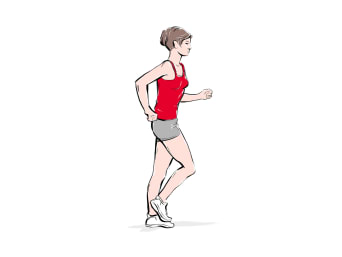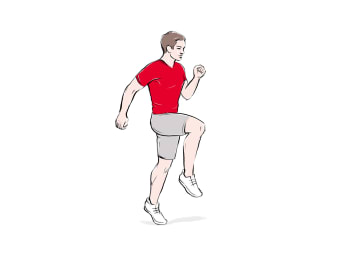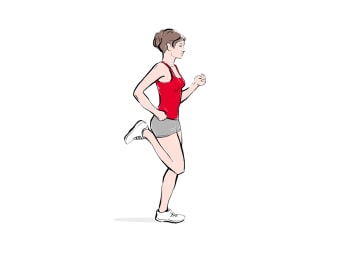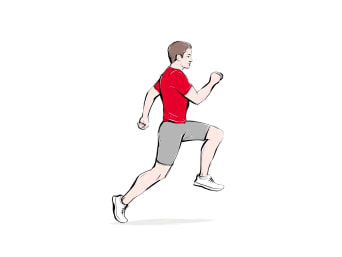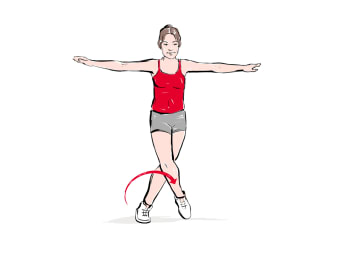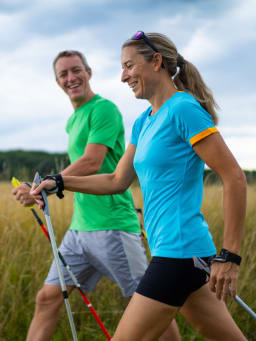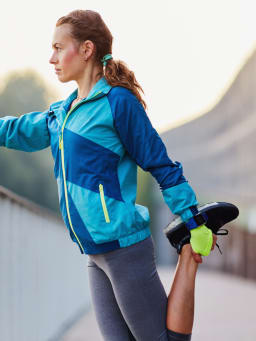Running for beginners: training, exercises & nutrition tips
Successful running training consists of different stages, in which you improve your performance, and give your body time to recover and adapt to more intense training. For beginners, it is not always easy to create a balanced running training programme or to choose the right type of training.
In this article we will show you the different ways to train. We also explain why a healthy diet can support your training and show you which gadgets could help you with your running training.
The basics of successful running training
The aim of running training is to increase endurance and speed and to improve your technique through specific running exercises. It is important to make sure that you practice the correct running form to avoid any injuries and also for better results.
The following building blocks are crucial for successful and sustainable running training:
Intensity: beginners should increase their running speed slowly and not start with too many goals.
Training duration: endurance training is considered effective from about 30 minutes. This duration is considered ideal for long, but not too intensive training sessions. Beginners can also achieve improvements after 20 minutes. Advanced runners often train for up to two hours at a time.
Training frequency: three training sessions a week is considered optimal. This means that there can always be a rest day between training days. However, one or two days a week is a good start for beginners.
The correct running form: while running you should keep an upright posture with an extended upper body. Your shoulders should be relaxed and your arms should be loose. Your feet should roll off the ground dynamically.
When running, you can choose from a variety of different workouts. It is best to combine different types of exercises to introduce your body to new challenges over time and to keep improving your running form.

Remember the ‘RICE’ rule if you have any injuries: rest, ice, compression, elevation. Stop exercising immediately after an injury. Afterwards, apply a cool compression and put a support bandage on it and then elevate it to help against swelling and pain. If the pain is severe or persistent, you will need to see a doctor.
Running ABC: everything you need to know
As the name "running ABC" suggests, these running exercises teach important technical basics that every runner should know. These exercises include ankle work, knee raises, heel raises, hop run and running backwards. If you practice them regularly and conscientiously, the running ABC exercises can help you develop a good running form that will improve your performance. The movements of the running stride are precisely reproduced and trained - from pushing off the foot and lifting the knee to the foot strike. In addition, hip mobility is improved. Running becomes more "economical" - you move faster and can also protect your joints by using the right technique.
How to train using the running ABC
Beginners should choose about three to five workouts and incorporate them into their run. Coordination training is demanding and requires concentration, therefore, don't take on too much at once. It is also important to not have an intense training session followed by lots of different exercises:
10 minutes run-in
10 minutes of running ABC exercises
10 minutes run out
Popular running ABC exercises to improve your running form:
Ankle work
This will also train your hips and improve the flexibility of your ankle joints.
Alternate knees slightly upwards, with gentle forward movements
Emphasise pushing the foot through
Tip of the lifted foot points towards the floor
Touch down starting with the front foot
Hips move with the foot and your arms should be bent
Knee raises
This exercise will help to improve your hip flexors.
Foot press from the ankle
Pull thighs alternately up to horizontal (higher than normal running height)
Your upper body needs to remains upright
Heel raises
This exercise will strengthen your leg muscles.
Bring your lower legs up to your thighs
Your heel should touch your buttocks
Hips remain extended
Run & jump
This exercise will strengthen your leg and gluteal muscles.
Powerful push-off from the ankle
Your leg should be stretched all the way up
Other leg swung forward (not upwards)
Your thighs need to be horizontal in the flight phase
Cross overs
This exercise improves hip mobility
Cross your legs sideways
place one leg alternately in front of and behind the other leg to the side
Your arms are extended and parallel to the floor
Upper body does not turn
Hop run
This exercise will strengthen your whole body.
Powerful foot strike from the ankle
Jump with a clear knee raise
Swing your arms upwards
Side steps
This exercise trains your inner thighs and strengthens your foot muscles.
Small lateral hops
Spread and close legs alternately
Change direction during the exercise
Walking backwards
Running backwards will train your calf muscles and improve your motor skills.
Walk backwards either slowly with short steps or faster with long steps.
Actively move your arms
How to increase your endurance for running
The relaxed endurance run is a longer run at a steady pace. You should never be completely out of breath. A prerequisite for running training, in general, is good basic endurance. Depending on your fitness level, you should gradually build up your endurance. The best way to do this is with longer but steadier endurance runs, where you do not push yourself to the limit. Jogging is a popular form of easy endurance running. This slowly prepares your body for a higher level of exertion. The duration of such a run can be between half an hour and three hours.
Tip: A slightly different variation of long-distance running is trail running. You could go on a trail run somewhere hilly or in the mountains. Not only is the distance important, but also how steep the inclines are. If you live in a town or city you could use stairs. This type of training puts more strain on the muscles and improves your strength.
How does speed play work?
Another form of endurance running is ‘speed play’, which brings a little bit of variety into your running training. This training involves a relaxed run with short intervals at high speed. There are no fixed rules for this running game. However, you should always alternate between a fast pace and a slow trot or even walking. The duration and intensity of the effort phase are important, but not the time or distance covered. The faster and longer the tempo phase, the longer your break should be.
Requirements for speed play
Always start and end the training at a moderate pace and not with a sprint. Warm-up and cool-down are important to help prevent injuries. You also need a certain amount of endurance before you can work on your speed. It makes sense for runners who run at least three times a week and can train for an hour at a time.
How to get started with training for speed play
You can increase the load in a pyramid style. Here is an example:
Run for 10 minutes
Build up load periods: 3 minutes, 6 minutes, 9 minutes, 6 minutes, 3 minutes
Alternatively: 2 minutes, 3 minutes, 4 minutes, 3 minutes, 2 minutes
Breaks between speed work at a trot or walking pace
Run for 10 minutes
What is interval training?
In interval training, you start with an easy run to warm up. Then you alternate between intensive load phases and recovery phases, which are often referred to as rest periods. As with the speed play, interval training requires a solid base of endurance. The distance and time targets are set in advance in an interval training plan. Many runners train on the 400-metre track to measure distance more accurately. However, the intervals themselves can be designed flexibly and vary to give you new challenges.
Interval training
The workout contains intense load phases and shorter recovery phases that are clearly defined, unlike speed play. Here is an example:
Run for 10 minutes
Load period: 5 x 1 kilometre sprints
Breaks between sprints: 90 seconds at a moderate pace
Run for 10 minutes
However, beginners can also organise their interval training like this:
Run for 10 minutes
Endurance period: run 400 to 600 metres in 2 to 6 minutes
Rest periods: between 90 and 120 seconds
Run for 10 minutes

Running training and practicing other types of sports
What are the benefits of practicing other sports with running?
Keeping active and playing sports can improve your performance and provide other health benefits:
Cycling is a good complimentary workout that strengthens stabilising muscles.
Swimming is easy on the joints and is also suitable as a gentle workout during periods of injury.
Strength training for legs and torso can improve poor posture.
Fitness gadgets - training aids for runners
Many ambitious runners want to keep track of their goals and progress. There are many ways to measure your improvements:
Fitness apps
Since smartphones are now an everyday companion, many amateur athletes use them as a fitness tracker. With the help of fitness apps and the integrated GPS, for example, you can record distance, average speed and calories burned. Some apps also contain special running challenges for extra motivation. One disadvantage, however, is that you must pair your smartphone with special heart rate monitors to measure your heart rate.
Fitness trackers
Many fitness trackers that are worn on the wrist work similarly to a fitness-focused smartwatch. They measure health data such as heart rate, record steps and calculate calories burned. Not every fitness tracker has GPS, as this often requires a connection to your smartphone.
Sports watch
Depending on the design, sports watches combine the advantages of fitness apps and fitness trackers. All training data can be measured and recorded independently on your smartphone, including GPS data and heart rate measurements (on your wrist or via an associated chest strap). Some models can even be used for swimming.
Nutrition tips for runners
A balanced diet forms the basis for a healthy lifestyle and is also directly linked to success. However, what is a healthy diet for runners and what tips should you follow?
A brief overview of healthy nutrition for athletes
Many dieticians recommend the following daily calorie intake: 55 to 60 % carbohydrates, 25 to 30 % (healthy) fats, 10 to 15 % protein. A healthy balance of the following foods is advised:
Carbohydrates from fruit and vegetables, cereals (e.g. oats, wholemeal bread and pasta), legumes
Fats from fish (e.g. pollock, tuna), eggs, nuts, seeds (e.g. chia seeds, pumpkin seeds), avocado
Protein from low-fat meat (e.g. chicken), fish, soy products, dairy products (e.g. cottage cheese, skyr), green leafy vegetables (e.g. spinach, broccoli)
Nutrition tips for successful running training
To ensure that you have enough energy for your training and can reach your personal goals, we have put together some important tips for nutrition for runners:
Don't eat anything hard to digest or high in protein before training. These foods can be heavy on your stomach and affect your training.
The last large meal should be about two hours before running. For some runners, it is sufficient if the last snack was at least 30 minutes ago.
Your metabolic rate is still elevated for about two hours after training. This is the ideal time to eat something and replenish your energy reserves.
Smoothies or shakes that contain carbohydrates and proteins (in a 3:1 ratio) are quick to prepare after training and do not put a strain on your digestion.
It is best to drink plenty of still water before and after training. Add a pinch of salt to your water or electrolyte drinks can prevent muscle cramps.
You don't necessarily have to drink during a run. You should drink something if you are running long distances, i.e. more than one hour or 10 kilometres, or if you are running in hot weather. A recommendation for high exertion is about 50 to 100 millilitres of water per 30 minutes.

If you have no known deficiencies and try to eat a balanced diet, you usually do not need food supplements or vitamins. If you think you may have any deficiencies, you should speak to your doctor or a nutritionist.
Conclusion: improving your running form and trying out new exercises
If you want to integrate regular running into your daily routine, it is best to start gradually. This will keep you motivated, prevent you from overdoing it, and allow you to build up your training successfully in the long term. Each runner will have different running goals. There are many training programmes, depending on your fitness level and what you want to achieve. Some of them teach the basics, such as running ABC, while others aim to improve your speed, such as interval training. It's best to vary your training and slowly take on new challenges.
______________________________________________
References and further information
https://www.coachmag.co.uk/exercises/1492/50-best-running-tips
(Last accessed on 11.01.2024)
https://impactmagazine.ca/fitness/workouts/running-abcs/
(Last accessed on 11.01.2024)
https://www.makeuseof.com/tag/smartwatch-vs-fitness-tracker/
(Last accessed on 11.01.2024)
https://www.nhs.uk/live-well/eat-well/what-are-reference-intakes-on-food-labels/
(Last accessed on 11.01.2024)
https://rebalancetoronto.com/abcs-of-running/
(Last accessed on 11.01.2024)
The image sources in this text are in chronological order:
Cover photo: iStock.com/dusanpetkovic
1. Image in text: iStock.com/alvarez
Exercise diagrams: C&A


